Stress, Worry and Anxiety
Understanding Stress, Worry and Anxiety
Sometimes we use these words to mean the same sort of thing. They are all linked but they are different, and it can help to understand a bit more about each.
They all are part of the way our amazing brain responds to danger and prepares us to stay safe.
Stress, Worry and Anxiety can affect our feelings, thoughts, and behaviour. We can get stuck in a cycle of negative or unhelpful thoughts, feeling and behaviours.
Click on the boxes below to jump to the Stress, Worry and Anxiety sections below.
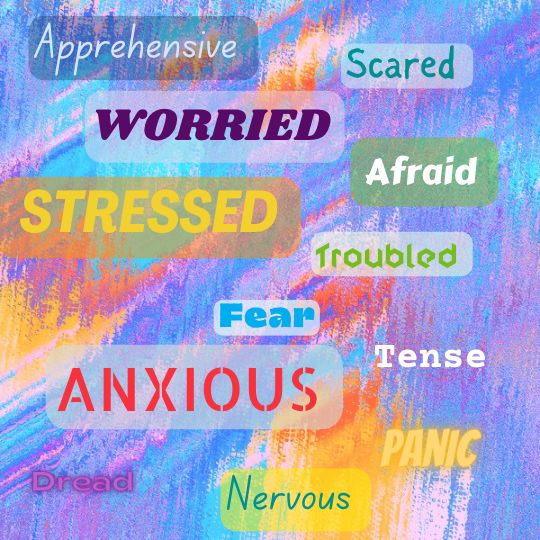

Stress
Stress is a normal emotion that everyone will feel at some point in their lives.
Stress can be a response a deadline coming up; an exam or taking part in a competition or being asked to read aloud in class.
It can sometimes be useful to enhance our performance, but it can become a problem when it interferes with our everyday life.
Stress Bucket
Imagine a stress bucket… what happens when stress flows into the stress bucket?
If it gets too full or even overflows it can feel overwhelming and messy.
But if your stress bucket has a tap it can be used to reduce stress levels so you can feel more normal and relaxed… Stress busters are the taps on your stress bucket making sure it can’t overflow.


Tips for managing stress
- Understand what things are in your control and those that aren’t. If you can't control it. Don't waste time and energy stressing over it!
- Get to know what triggers stress for you – so you can spot when it’s happening and get in quick with your stress busters.
- Get to know the stress busters that work for you
- Make sure you reward yourself for doing something that causes stress by doing something that you enjoy and helps you feel more relaxed and happier. These are called coping strategies.
Stress Busters
Here are some stress buster ideas from the Ways to Wellbeing. What would you add to this list?
Get Moving– any form of activity is a great stress buster.
Connect – spend time with family, friends, or pets.
Take Time for You – Read, play games, watch a favourite movie, have a relaxing bath or shower
Take Notice – Stop for a moment and concentrate on your breathing with a calming breathing idea or try ‘54321’
Give – yourself a break! Try using positive self-talk statements. Give to others. Any acts of kindness, whether small or large can make you feel happier and more satisfied about life.
For more about managing stress, our fabulous friends at WeHeartCBT have some brilliant information and ideas for young people and parents and carers. Check out their Managing Stress: Young Person's Factsheet
Worry
Worries are often thoughts about specific things that could go wrong.
“If I can’t find my PE kit, I’m going to miss the bus” or “I’ve got to speak in assembly tomorrow and I’m going to forget my lines and look really stupid!”.
Worries are often temporary (e.g., until you do catch / miss the bus)
Worries can be helpful. They can give us a prod to think about problem solving.
Worry: “I’ve got to speak in assembly tomorrow and I’m going to forget my lines and look really stupid!”.
So, you might think. OK, what can I do so that I don’t forget my lines and/or look stupid?
- I could make sure I learn them off by heart tonight before I go to bed or,
- I could ask the teacher if it’s OK to have them written out to have with me, just in case.
What to do about Worries
Whether you've got a few worries about starting at a new school or worried about what the next year will be like - you're not alone, lots of students feel this way and it's perfectly normal!
Here are some things young people in Cornwall told us they were worried about:

Worry Walt
Worries, including 'What if...?' worries can be a pesky problem. So it's a good job "Worry Walt" is here with some great ideas how to deal with them...
When worries and 'what ifs' fill your mind. Check out my top tips for managing them
Worry Walt's Top Tips:
- Catch worries by writing them down
- Understand worries - what type of worry is it?
- Don't let worries take over - use Worry Time
- Tackle your worries using the Worry Tree
If you notice you are worrying about something during the day... write it down to deal with later. Once you've written it down, try not to let it distract your focus. Let it go until you're ready to deal with it. Here are ideas to help you let go of worries and refocus your attention.
Is it a 'What if...?' worry - which are 'hypothetical' - and we can't do anything about (and may never happen) - like "What if no one talks to me at the party?" or a 'practical' worry - worries that you can deal with (hurrah!) - like "I'm not used to using the train. How I make sure I get the right one?"
It can be distracting and difficult to be thinking about your worries all the time. Set aside some worry time to look at the worries you've caught. For each one decide if it is a practical or a 'what if...?' worry.
Managing worries
Download a copy of Walt's Worry Workbook - our simple guide to managing your worries.
For more about managing worries, our fabulous friends at WeHeartCBT have some brilliant information and ideas for young people and parents and carers. Check out their Managing Worry: Young Person's Factsheet
Our Start Now Wellbeing and Resilience Action Plan and Toolkit is full of things to do to help you manage your worries; distraction and calming ideas; and loads more...
Walt's Worry Tree
There's not much you can do with a 'What if...?' worry except let it go. And with practice that can become easier. With a practical worry have a go at problem solving.
Use the interactive Worry Tree below.
You can download the Worry Tree in the Worry Workbook - a pdf document to help you manage worries or click here for a good video about how to use a worry tree.

Catch the worry
Is it a 'what if..?' or a 'practical' worry?
Let the worry go
You can let the worry go by ripping up or scrunching and throwing it away... or imagine it float away like a balloon in the breeze...

Choose a favourite way to distract yourself
There are some great ideas here and in the Toolkit #YouGotThis

Problem solving
What can you do? What will be most likely to help? Do you need anyone to help you?
Can you act right now or later?

Do it!

Think about something else
Use a calming/distraction activity to refocus your attention like 54321 Relax! in the Toolkit
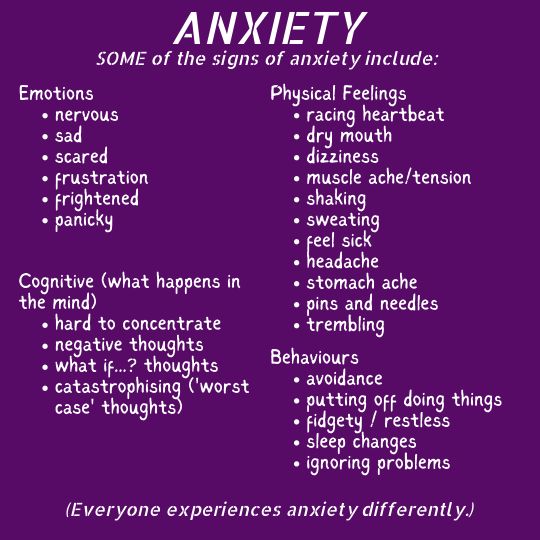
Anxiety
- Anxiety is a normal emotion that everyone will feel at some point in their lives.
- Anxiety is what happens when our bodies think we are under threat.
- Anxiety is more than just feeling stressed or worried - it can make life really tough by making it difficult to do certain things. You might constantly feel like bad things will happen or feel nervous / on-edge all the time.
Signs of Anxiety
The signs of anxiety include thoughts; emotions; physical feelings and behaviour
Remember to seek help if you feel anxiety is becoming a problem and taking over your life. Talk to a trusted adult – at home or school or your GP
This is a really good video about understanding anxiety.
Managing Anxiety
The good news is that there are ways we can manage anxiety.
1. A good place to start is by trying to understand more about anxiety and what's happening in your brain...
Check out this video for some brain basics on anxiety.
2. Here are some things to help take back control of your body and brain:
- Challenge your negative thoughts
- Face you fears
3. Remember those stress busters? Well, they are also great for helping to manage anxiety too!
Challenging Negative Thoughts
Many negative thoughts happen automatically and can seem to come out of nowhere and are almost always untrue! By taking notice of our thoughts, we can challenge and change them rather than just believing them to be true.
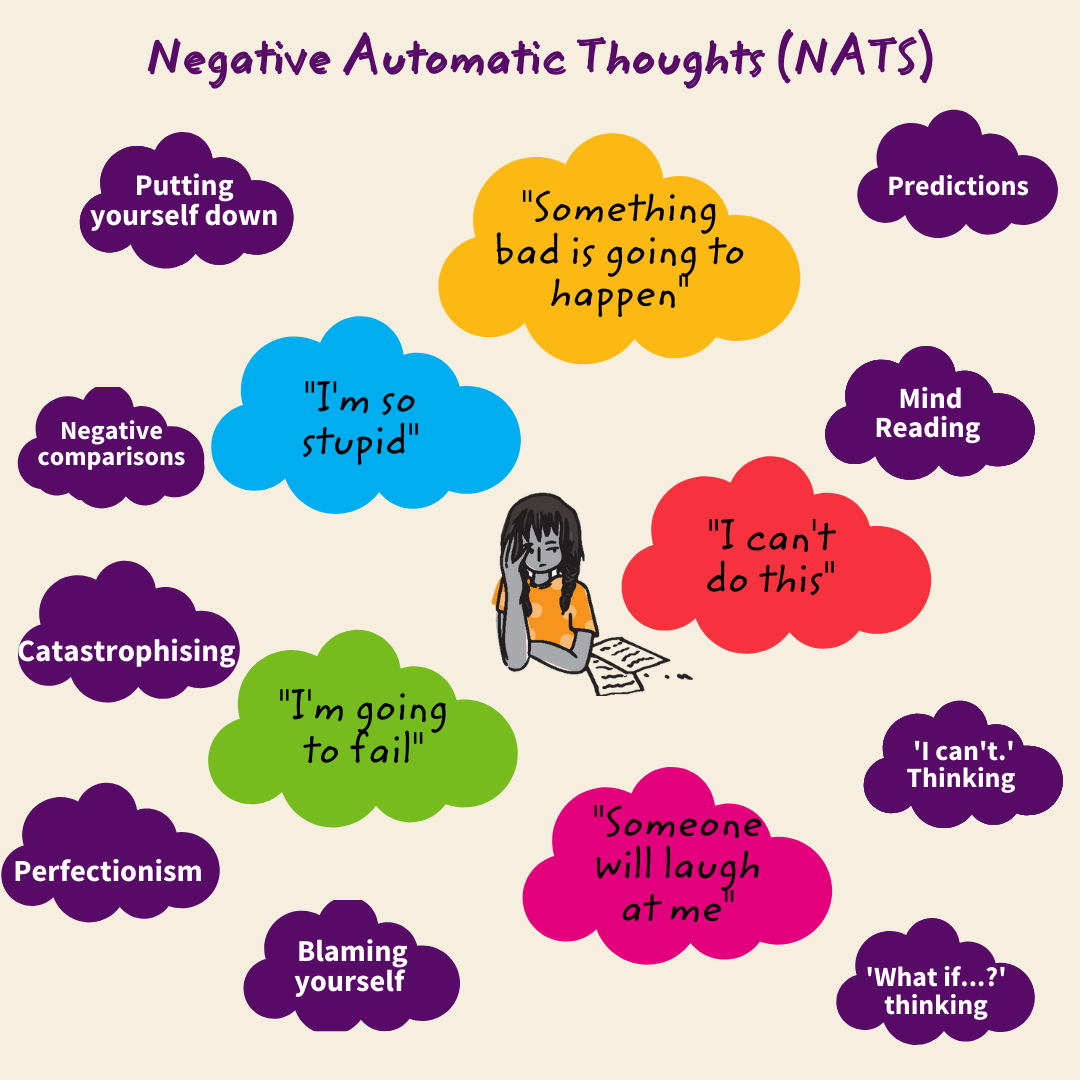
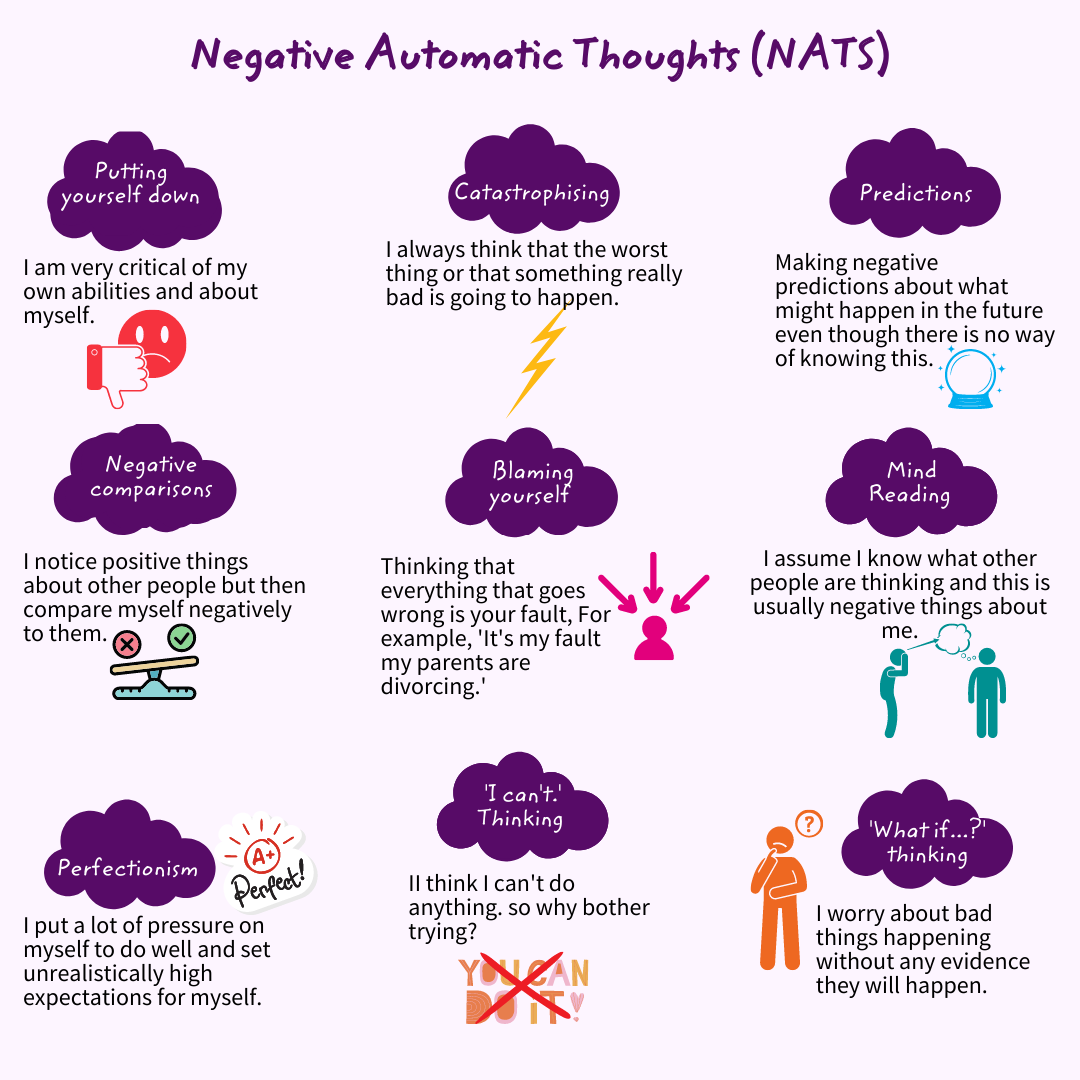
Types of Negative Thoughts
There are some common anxiety-related thought patterns. These can be divided into two broad groups:
- Expecting things to go wrong and, very badly wrong
- Thinking negatively about yourself
For example:
- Catastrophising
- Predictions
- Mind reading
- "What If...?" Thinking
- Putting yourself dowm
- Nagative comparisons
- Blaming yourself
- Perfectionism
- "I can't..." Thinking
Challenge negative thoughts
A great way of starting to manage anxiety is to challenge negative thinking and those pesky NATS.
- Pay attention to your thoughts.
- If you notice negative thoughts, think "STOP! I need to check this thought out".
- Check out the thought by asking questions like 'What sort of thought is this?'
- Challenge the thought and think about how you could change the thought to something more realistic and positive.

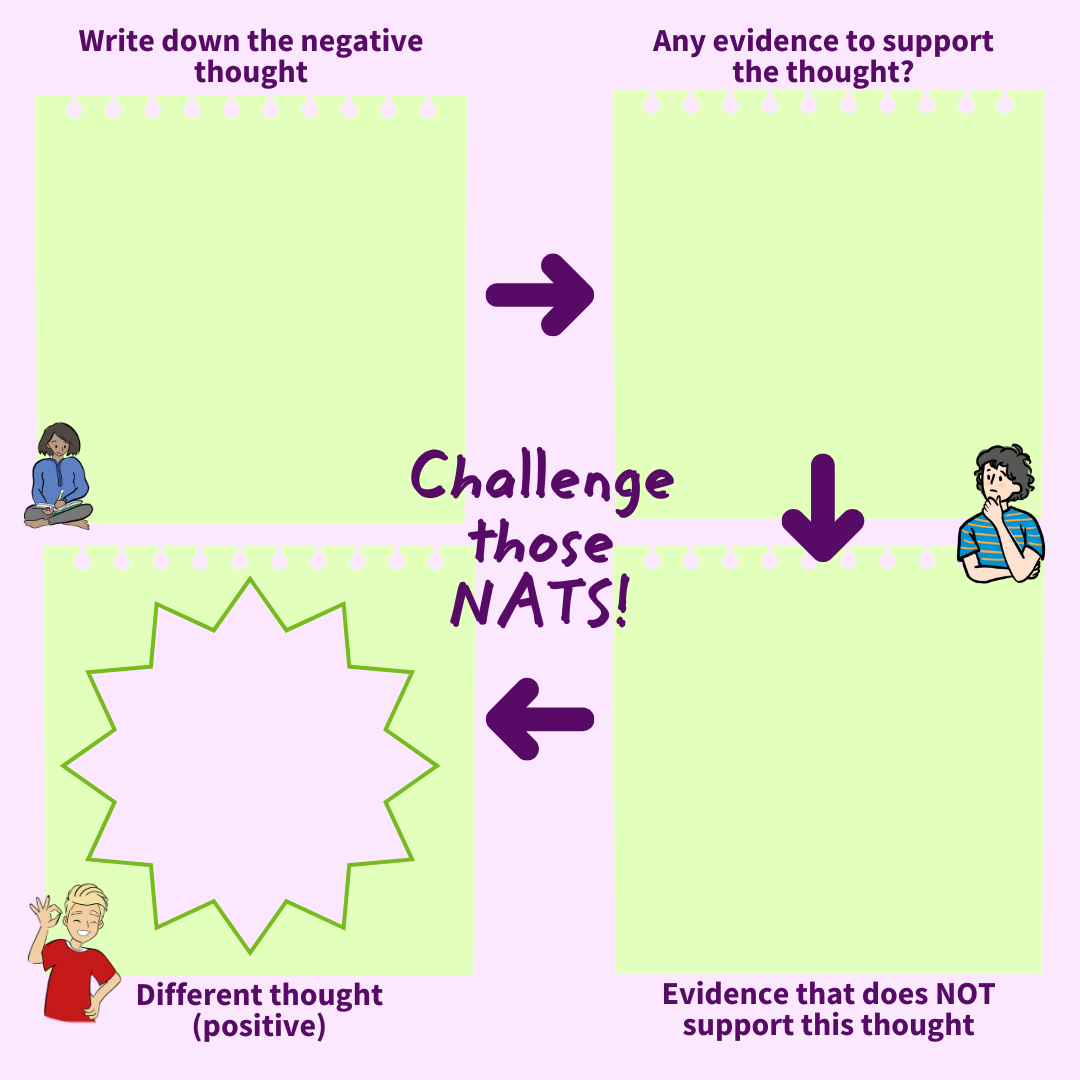
Challenge your negative thoughts tool
It often helps to write down the steps when you are challengeing your negative thoughts.
You can find Challenge your Negative Thoughts download in the Wellbeing Toolkit
Facing your Fears
Another helpful technique to try when you are managing anxiety is to try and face your fears. You can do this by doing the things that you are often don't want to do because your anxiety tells you it's too risky.
Not doing stuff because of anxiety in called avoidance.
This can stop from doing things that you could enjoy or benefit from if it wasn't for anxiety.
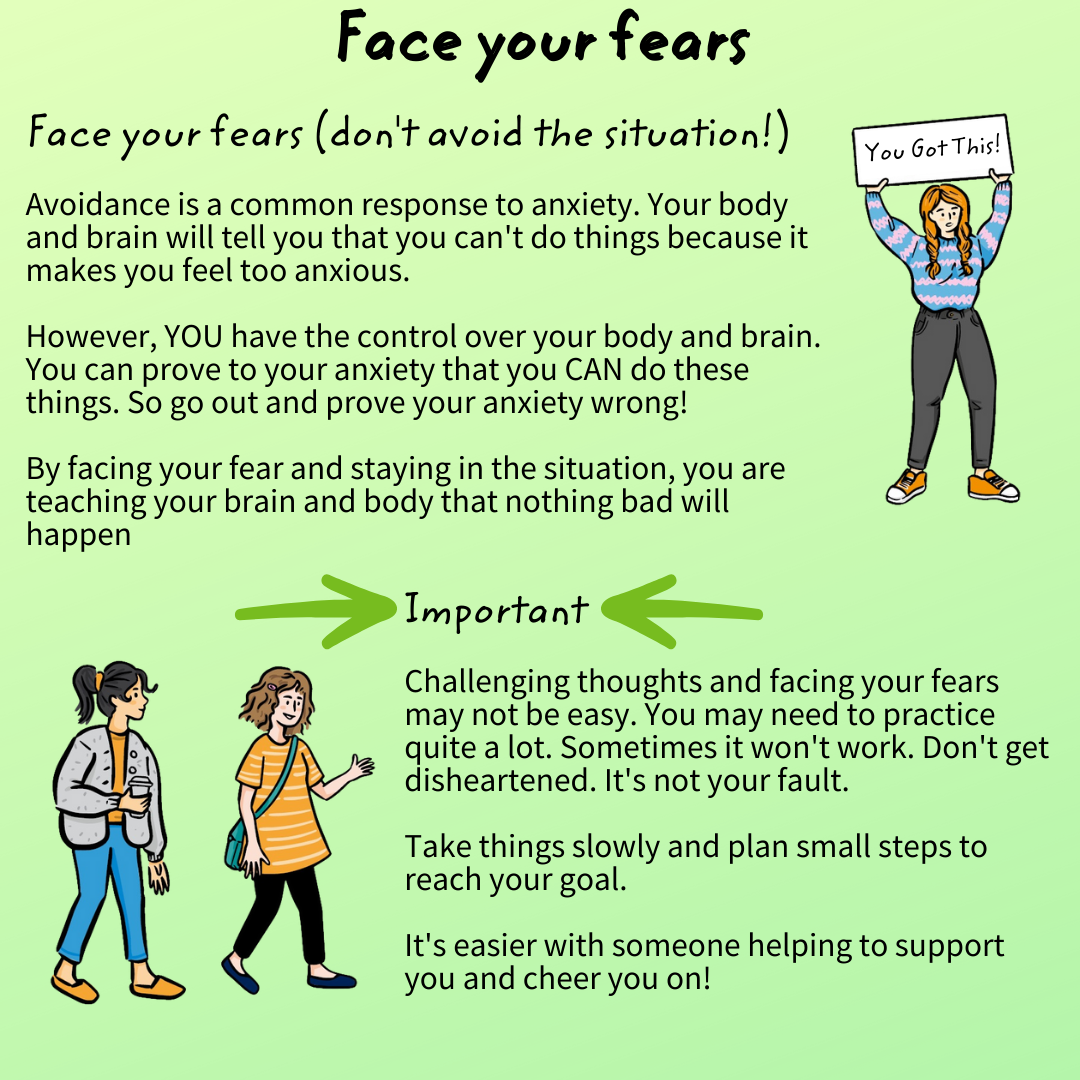

Try the Anxiety Ladder
A good way of facing your fears is to approach them gradually. Try small acheiveable steps towards making your goal.
Check out the Anxiety Ladder. It is a great way to look at something you are anxious about, decide what your overall goal will be and problem solve / plan the best way to get there.
Top Tip!
Set yourself some goals and it will make it easier to achieve what you want to.
Start off small and slowly build your way up to the situation where you feel the most anxious.
Remember, your goals should be realistic and achievable.
Create your own anxiety ladder
You can find an Anxiety Ladder template in the Wellbeing Toolkit.
